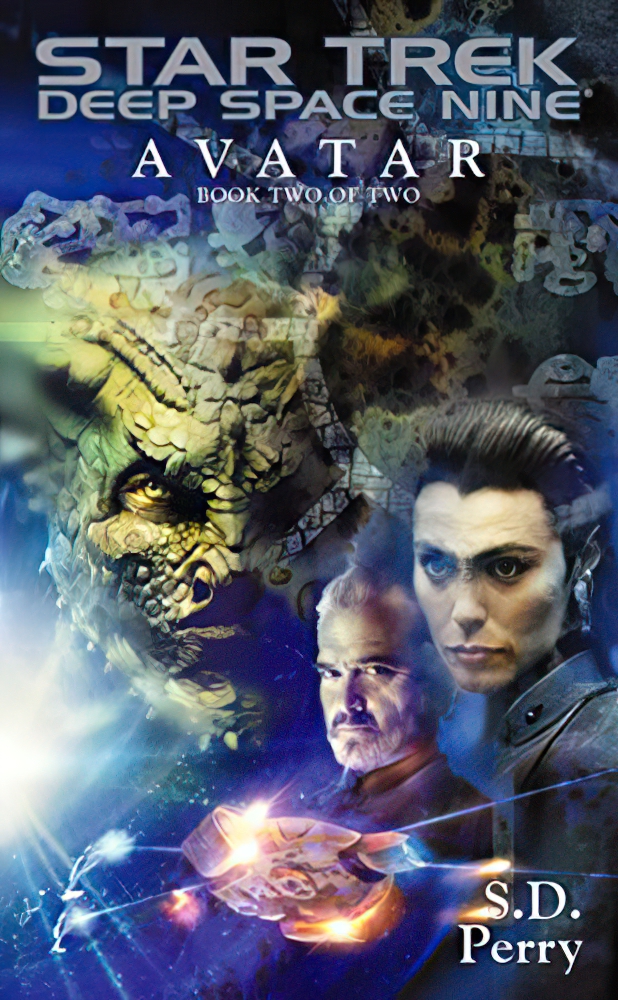 Story: The discovery of an ancient prophecy about 10,000 deaths before the birth of the Avatar – the son of the Emissary – worries Kira and Ro. When Vedek Yevir is summoned to investigate the ancient book, he instantly denounces it as the writings of a Bajoran heretic cult that turned away from the teachings of the prophets. But Kira isn’t so sure – all of the prophecies thus far have come true. She doesn’t have time to worry about it, however, when a new crisis arrives – the Jem’Hadar soldier who claims to have come to DS9 under orders from Odo breaks out and goes on a killing spree, making his way toward the station’s reactor core to overload it. Commander Vaughn, having just arrived aboard the recently-docked Enterprise-E, helps Kira to prevent the station’s destruction, but the two only survive with the help of another Jem’Hadar who claims to be on the same mission. A Starfleet attack force masses in anticipation of a new Dominion War, unless the new Jem’Hadar arrival can prove what he says to be true – and Kira unleashes chaos on Bajor by revealing the forbidden prophecies to the general population…only to discover that the prophecy of 10,000 sacrifices has already come to pass.
Story: The discovery of an ancient prophecy about 10,000 deaths before the birth of the Avatar – the son of the Emissary – worries Kira and Ro. When Vedek Yevir is summoned to investigate the ancient book, he instantly denounces it as the writings of a Bajoran heretic cult that turned away from the teachings of the prophets. But Kira isn’t so sure – all of the prophecies thus far have come true. She doesn’t have time to worry about it, however, when a new crisis arrives – the Jem’Hadar soldier who claims to have come to DS9 under orders from Odo breaks out and goes on a killing spree, making his way toward the station’s reactor core to overload it. Commander Vaughn, having just arrived aboard the recently-docked Enterprise-E, helps Kira to prevent the station’s destruction, but the two only survive with the help of another Jem’Hadar who claims to be on the same mission. A Starfleet attack force masses in anticipation of a new Dominion War, unless the new Jem’Hadar arrival can prove what he says to be true – and Kira unleashes chaos on Bajor by revealing the forbidden prophecies to the general population…only to discover that the prophecy of 10,000 sacrifices has already come to pass.
Review: I was sharply critical of the first volume of the two-book “Avatar” because it seemed like it was all setup. Book two is all payoff, and it really does redeem the story as a whole. Maybe this is a better relaunch for Deep Space Nine than I was really capable of giving it credit for after reading only the first book.
Again, the characterizations are spot-on, but the characters begin to interact on a deeper level in the second book. Now I can see where the author was going by adding Ro Laren to the DS9 mix. Elias Vaughn, the secretive 102-year-old Starfleet Security operative who spent all of the first book aboard the Enterprise, also comes into a sharper focus, and we’re given a sound reason for him to become DS9’s new first officer. (The irony of the station now operating under a Bajoran commander and a human first officer isn’t even touched on in the text.) We even get a resolution of Ro’s betrayal of Picard and Starfleet by the end of the book, which wasn’t absolutely essential to the story but helps to bring Ro more firmly into a sympathetic spotlight.
I criticized the first book for turning its back on Star Trek’s innate ability to comment on issues; this volume certainly redresses that balance with a firm focus on fundamentalism vs. a more mature view of religion with a rational, objective component. That it doesn’t reject all belief outright – which seemed to be a direction that Star Trek, by way of Roddenberry, leaned in at times – is an interesting element, and something that really works best in the DS9 corner of the Trek universe, as opposed to, say, Voyager or Enterprise.
There’s a revelation involving a new Andorian character which showed up on my sensors as a bit of a “so what?”, but given how well things have already developed from the first book to the second, I’m willing to wait that out and see where it’s going.
Year: 2001
Author: S.D. Perry
Publisher: Pocket Books
Pages: 234

